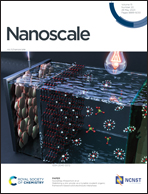Dual-inhibition of lactate metabolism and Prussian blue-mediated radical generation for enhanced chemodynamic therapy and antimetastatic effect†
Abstract
Numerous research studies have proved that lactate is pivotal in tumor proliferation, metastasis, and recurrence, so disrupting the lactate metabolism in the tumor microenvironment (TME) has become one of the effective methods of tumor treatment. Herein, we have developed a versatile nanoparticle (HCLP NP) based on hollow Prussian blue (HPB) as the functional carrier for loading α-cyano-4-hydroxycinnamate (CHC), and lactate oxidase (LOD), followed by coating with polyethylene glycol to enhance chemodynamic therapy (CDT) and the antimetastatic effect of cancer. The obtained HCLP NPs would be degraded under endogenous mild acidity within the TME to simultaneously release CHC and LOD. CHC inhibits the expression of monocarboxylate transporter 1 in tumors, thereby interrupting the uptake of lactate from the outside and alleviating tumor hypoxia by reducing lactate aerobic respiration. Meanwhile, the released LOD can catalyze the decomposition of lactate into hydrogen peroxide, further enhancing the efficacy of CDT by generating plenty of toxic reactive oxygen species through the Fenton reaction. The strong absorbance at about 800 nm endows HCLP NPs with excellent photoacoustic imaging properties. Both in vitro and in vivo studies have demonstrated that HCLP NPs can inhibit tumor growth and metastasis, providing a new possibility for tumor therapy.



 Please wait while we load your content...
Please wait while we load your content...